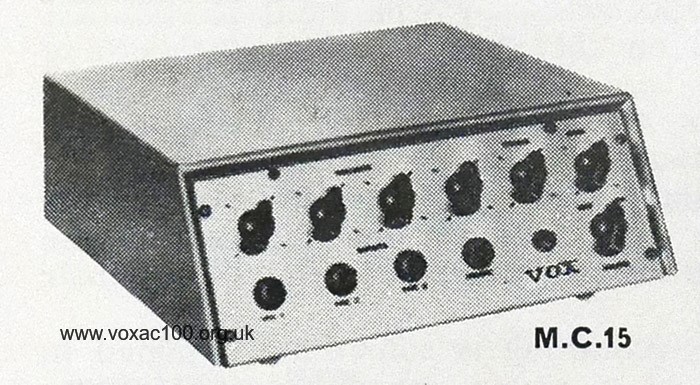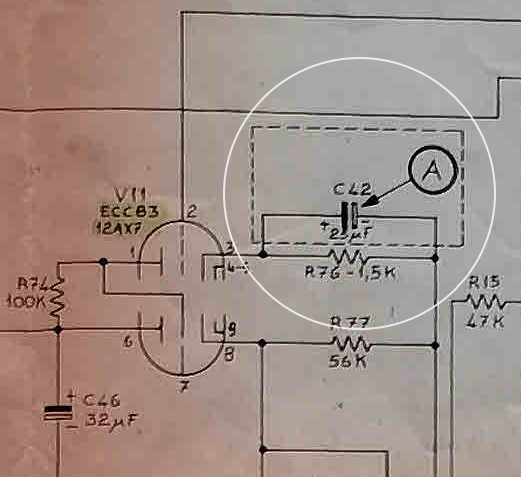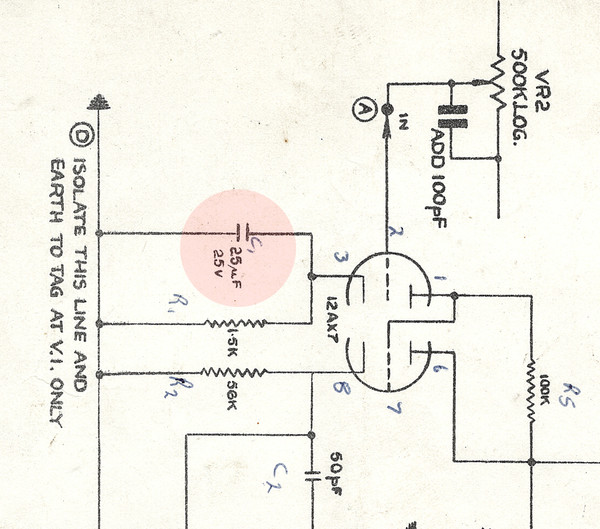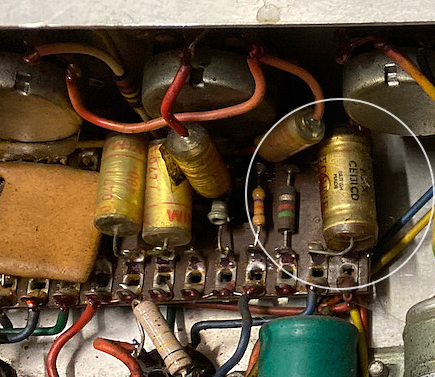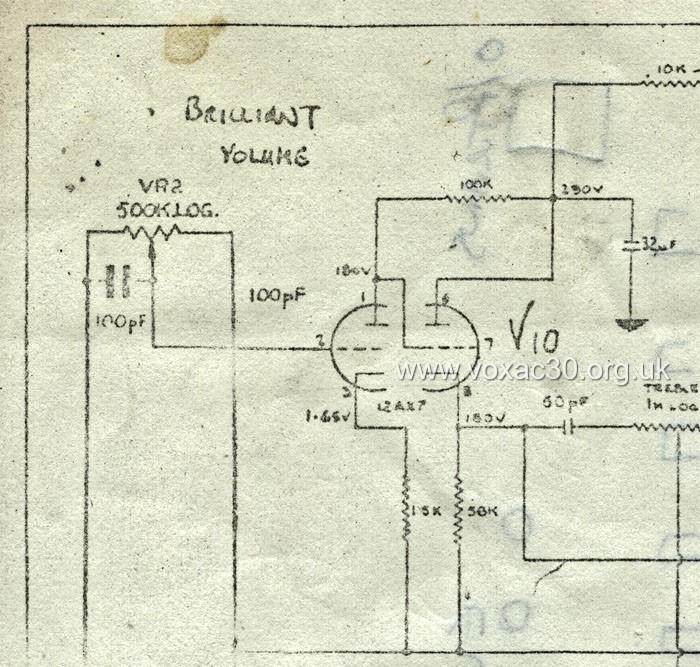Vox AC30 website updates
January 2023
30th January
Thanks to Robert again, a promotional picture of his band taken c. 1962/1963 at Elstree Studios for a film that ultimately did not come to be. The singer, who was not a member of the group, was brought in specially for the shot. Robert is to the right of the drummer.
The matching two-tone AC15s (blue/grey and oatmeal) - a "Normal" and a "Bass" - are third circuit amps, produced in the second half of 1960.
29th January
Thanks to Robert Valentine, who worked for JMI from 1959 to 1964, a shot of the combo created for him in the 1970s by Dick Denney - a JMI AC30 chassis in a "Jennings Electronic Industries" AC40 case, Top Boost controls added on the front.
Detail from a larger view of the stage.
24th January
Just to signal the addition of a new page on the Vox MC15 public address amplifier on the Vox AC100 website.
Detail from a JMI advert published in the music trade press, December 1964.
The MC15's power section evidently stands in close relation to that of the AC15 combo and twin, though precise details are yet to be determined. The transformers in the amplifier illustrated on the new page - produced in the third quarter of 1964 - were sourced from RD Electronics either by Jennings or Triumph Electronics, which assembled the Metal Clad range under contract. The same set of transformers also figures in at least one AC15 Twin - serial number 3874, certainly early 1963, chassis probably also made by Triumph.
22nd January
Some material mainly on the AC2 / AC4 / Domino circuits. The earliest surviving diagram for the AC2 / AC4 is OS/009, dated December 1961. There is also a further sheet, un-numbered, but identical otherwise.
Between late 1960 (the first AC2s) and late 1964 very few amps were constructed in conformity, perhaps not too surprising though, as these circuit diagrams are not blueprints. They were drawn up and circulated largely for repairmen.
The point to observe initially is the value of the grid resistor between the EL84 and the wiper of volume pot, given as 5.6K.
Detail from the AC2 circuit diagram drawn out by John Bell on the 9th December 1961.
The actual values used in production were:
Late 1960 - late 1961:: 4.7K - AC2 serial numbers 2000 to c. 2200. See this page for pictures.
Late 1961 - late 1964: 6.8K: - AC4s with pink/champagne coloured panels, serial numbers c. 2200 to 4100. Production contracted out to Triumph Electronics in Purley. Also to note that Triumph changed the relative positions of the EZ80, EL84, and main filter capacitor on the chassis. New holes - ie. a new design of chassis - were not required however as the components were of the same diameter - i.e. the socket for EZ80 fitted perfectly into the cut-out used up to that point for the EL84.
Late 1963 - 1965: 6.8K: - Domino Standard/Normal combos. These have the same circuit as the AC4.
Late 1964 through to end of production: 5.6K: - AC4s. Present in serial numbers 4257 and 4761. At last, the value specified in OS/009.
Most of the AC4s in the first batches sent over to the USA will have had a 6.8K value in place - and when Thomas Organ came to redraw the JMI circuit diagram a 6.8K was indeed the value stipulated. In many respects the Thomas diagram is easier to use than JMI's, laid out more clearly, and printed rather than hand-drawn.
Detail from the Thomas circuit diagram for the AC4.
Strangely, JMI never caught up. Circuit diagram OS/051 - "AC4 Amplifier and Domino Normal" - drawn first in March 1964 and redrawn in September has the 5.6K resistor.
Detail from OS/051, drawn by Albert Hogben.
The change in value of the on/off/tone pot from 50K (in the AC2 diagram) to 1M (OS/051 and Thomas) is more difficult to chart at present. Perhaps more later.
Where other models of Domino are concerned, the "Domino Bass" was effectively an AC4 voiced differently and without the ECC83 tremolo circuit; and the "Domino Reverb" and "Domino Super Reverb" species of AC10 Super Reverbs, as mentioned below (entry for 16th January).
21st January
Below, an advert placed by JMI in the music trade press in November 1964, further promoting some of the items displayed at the Russell Hotel in August. Included among the lines available, the Domino amplifiers - a rare mention outside catalogues and pricelists.
November 1964.
An introductory page on the Domino range - as ever to be augmented shortly - has been started here. Pages on the individual models to follow.
Pictured below, a Jennings badge in Gothic "type" on an AC4 (also posted in the entry for 18th January).
The Domino logo (and revamped colour scheme) of late 1964 can be seen on this Domino Bass amplifier section:
20th January
Thanks to Lou, some new material on the Top Boost circuit of Italian-made AC30s. On the E.M.E. circuit diagram for the AC30, drawn out in late 1968, the cathode bypass capacitor (25uf) of the ECC83 that drives the top boost network has a dotted line around it.
An "A" in a circle indicates the presence of a note, which is to be found above the information panel: "Solo sullo schema elettrico originale" - "only on the original circuit diagram".
Details from the E.M.E circuit diagram for Italian-made AC30s.
As Lou notes, Italian-made AC30s - Top Boost and Top Boost Reverbs - conventionally do not have this capacitor. The page on these amps, which will need updating, can be found here.
Italian-made AC30 serial number 30748.
JMI
The position of the 25uf bypass cap in amplifiers assembled for JMI by Westrex and Burndept can be seen in the details below:
Detail from the JMI diagram for the Top Boost circuit. A page illustrating the various versions can be found here.
A chassis with with integral top boost in its copper control panel, assembled by Westrex, serial number of the AC30 unknown, but likely to have been in the 10000s.
Detail of the chassis of AC30 Super Twin serial number 5438 TB - probably early 1967. Its Woden choke has the date code "KX" = October 1966.
Whether the text of the note on the Italian sheet means that the sheet as a whole was a close copy of some pre-existing (consolidated) JMI diagram for amps with integrated Top Boost is difficult to say for certain. No JMI sheet for these amps has come to light. But there must have been one (as has been mentioned previously).
It is interesting to find though that OS/013, drawn up by "Vox Sound Equipment Limited" in late 1969 shortly before it collapsed, makes just the same omission as the E.M.E. diagram - no 25uf bypass capacitor for the top boost driver valve. This capacitor certainly seems to have been omitted from the English-made AC30 chassis assembled by VSEL and VSL with traditional tag boards (1969-1971); and probably also from the Birch-Stolec PCB-based amps of 1971-1973.
Detail from OS/013, dated 20th November, 1969. Could the capacitor have been erased? There would otherwise be no reason to represent the 1.5K resistor with such a dog leg line.
19th January
More on the Jennings range of Domino amplifiers. Although precise beginnings are hard at present to pin down, official reports show that Tom moved to trade mark the name in late September 1963 - "sound amplifiers for musical instruments", so certainly a new line (rather than a single model). Approval (registration) was slow in coming, however, not being granted until October 1965.
The line as a whole was evidently ready though by the late autumn of 1963, three of the four amps being illustrated in the "Precision in Sound" fold-out catalogue; and it seems likely that at least some of the range (if not all four) was shown for the first time at the Russell Hotel Trade Fair of August 1963.
The comments below (entry for 17th Jan.) on the Fair of August 1964 need to be put in context. The report mentioning the "New Domino commercial range of Amplifiers" only told part of the story. A further report - which can be seen here - indicates that the range was not in fact new at that time but simply being updated: - "...the inexpensive Domino range with a new appearance".
It is to be hoped that definitive information relating to the showing (or not) of the Dominos at the Russell Hotel in August 1963 comes to light in the near future.
"Precision in Sound" fold-out catalogue of late 1963. These are the best catalogue illustrations issued by JMI. The ones embodied in the catalogue of 1964 are not nearly as sharp.
Intitially the combo without reverb was termed the "Domino Standard", as it is in the "Musicland" pricelist that was often bundled up with the "Precision in Sound" catalogue. Later the "Standard" came to be known as the "Normal".
Detail from a "Musicland" price list, probably late 1963, accompaunying "Precision in Sound" catalogue and "Vox People" brochure.
Detail from the JMI pricelist of Spring 1964.
Just to add that the brochure-manual dated August '64 - cover illustrated below - was evidently produced or revised to accompany the revamping of the line. More to come soon.
18th January
Details of a species of Domino Bass "piggy-back" (Super Twin) amplifier section. The Domino Bass was issued in a variety of forms over a relatively short period. This one had a bronze Jennings plaque attached, presumably a left-over from the late 1950s. The chassis was signed in pencil "DE" = Dave Earp, who worked for Triumph Electronics from c. 1964 to 1966. Dave signed off numerous AC50s (also assembled, initially at least, by Triumph).
Chassis, in this case simply a standard AC4, signed off in pencil by Dave Earp.
Dominos generally had plates with "AMPLIFIER" rather than "VOX AMPLIFIER" at their head. Below, one not otherwise recorded - a plastic Domino plate, early type with short information panels. At certain points later versions of these plates - with long information panels - were also used on amplifiers in the main Vox line.
The plate of a Domino Reverb combo amplifier.
17th January
Another slight tangent, though one that will ultimately link up with coming pages on the AC4, the nominal successor of the AC2 of late 1960 and 1961. The page on AC4s, late 1961 into 1963, can be found here.
The Domino range of amplifiers was introduced to the public for the first time at the Russell Hotel Trade Fair, late August 1964, and illustrations of three of the four models included in the newspaper-format "Precision in Sound" catalogue issued in September. [ - see now the entry above, 19th January, for further clarification.].
JMI Dominos, September 1964. The model not depicted is the "Domino Super Reverb" sometimes termed the Super Reverb Twin.
To accompany the release of the amps [ - this should be "release of the updated range"], a short brochure-cum-manual was drawn up, the printer's runner dated August 1964.
Domino manual.
Detail of the printer's runner, August 1964.
Chassis were produced under contract for JMI by Triumph Electronics in Purley, which was already assembling chassis for the AC4. In many respects, the smaller Domino amps were simply flavours of AC4. Some of the mains transformers employed were sourced from "Allen", about which little is known at present.
Detail from an early Domino Bass amplifier. Allen used the same logo - an electron orbit - on later (1960s) units too. Early Simms Watt and Sound City amps have Allen transformers but without logos on the stickers.
Allen also provided the mains transformers for the Vox Traveller amplifier, early 1967 to late 1968, fully solid state, 10 watt ouput. Travellers were assembled at Erith.
Other batches of mains transformers for the Domino range, along with units for AC10s and certain tape Echo machines, were sourced from "JD Electronics", based in Corsham in Wiltshire (registered office only in Birmingham).
16th January
Continuing down the byway of the "Mystery Amps", some old pictures of one that appeared quite a while ago now. The insides of these amps are not often illustrated. The cut-out for the chassis on the slider board is professionally done. The circuit, as noted in yesterday's entry, is that of the Domino Super Reverb and slope-sided AC10 Super Reverb Twin. In the amp below, a later reverb pan has been used - of the type fitted to the Vox solid state amps of late 1966 / early 1967.
At least one of the Mullard mustard capacitors has the date code "D4N" = last quarter of 1964. There is an "H" in pencil on the chassis, which one often finds on amps assembled for JMI by Triumph Electronics. It is not clear what "A87C" signifies - perhaps one of JMI's mechanical (layout) drawings? These normally had "A" prefixes.
Also worth noting are the cut-outs for the amplifier sections in the Lightweight and Mystery Amp cabinets - the opening in the case of the latter being wider but less tall. It is possible that with care and skill the basketweave covering of a finished Lightweight cabinet could have been peeled back and a new wooden cut-out section slipped in (the flap of original vinyl then re-applied).
The other possibility of course is that there were batches of Lightweight cabinets available that had not yet been covered. Remember that the cabinets are indeed for the Lightweight amplifier, cut-outs for the tremolo controls in the back panel.
Lightweight Transistor 30.
"Mystery Amp". The speakers in these amps are normally Elacs (as in the Lightweights).
The over-arching question - an open one - is what would JMI have been doing producing such amplifiers in 1965? None has a serial number plate.
15th January
Some notes on the "AC30 Transistor Lightweight" and the so-called "Mystery Amp" (sometimes called the "AC20" though with no support from any early source).
Below, front and rear of an early AC30 Lightweight simply for orientation. Serial numbers initially were in the sequence used for T60s as the amplifier embodied in the Lightweight was indeed a T60. Later Lightweights were given numbers in the main AC30 sequence. The plate of number 13939 is pictured below. If memory serves, AC30 Lightweight serial numbers go through to the 15000s.
AC30 Lightweight serial number 504. The tremolo circuit - controls in the back panel cut-out - is set out in JMI diagram OS/041.
AC30 Lightweight serial number 13939 - "L" for Lightweight.
As has long been known, AC30 Lightweight and "Mystery Amp" cabinets are effectively identical, the only difference being a wider cut-out for the amplifier chassis of the latter. The cut-outs for the Lightweight tremolo - redundant in the case of the "Mystery Amp" - were covered with mesh.
Detail of the upper section of a "Mystery Amp".
The amplifier chassis of the "Mystery Amps" are the same as those developed by JMI in 1964 for the Vox Domino Super Reverb Twin (copper panel); and the new AC10 Super Reverb Twin (grey panel, slope-sided cabinet). The AC10 and Domino amps have link voltage selectors first, then dome.
All the "Mystery Amps" that have surfaced so far have dome voltage selectors and non-standard black control panels. Component date codes indicate assembly in 1965 or later. More on this in due course.
12th January (2)
A note on Hank's comments reported by Royston Ellis in "The Shadows by Themselves" (1961). Ellis was the "ghost writer".
Page 108.
Hank's amp, which was in his hands by early March 1961, is said to have had some sort of "booster". This in theory could have been one of three things:
1) Some version of the Top Boost circuit, though "Top Boost" as we know it was not officially advertised/signalled by JMI until the summer of 1961 - see this page. A photo taken in June 1961 shows that none of the three amps used by The Shadows had controls on their back panels. If the "booster" was indeed a "Top Boost" circuit in some form or other, then it was built in - ie. part of the voicing of the amp.
2) The word "booster" was used simply for clarity (for the general reader), the intention being to indicate that Hank's amp was voiced differently from Bruce's. Perhaps something akin to the "Treble" voicing formally introduced in 1964?
3) Aside from the "booster", Hank and Bruce's amps are said largely to have been the same. Was Jet's different in this case? If one were to guess at voicings: Jet = "Bass"; Bruce = "Normal"; and Hank = "Treble".
4) Did Hank's amp have an EF86?
Several "sightings" of these AC30 have been claimed over the past 30 or so years, each (naturally) pouring cold water on previously reported sightings. It was much the same with Lennon's fireglo Rickenbacker 325 - various claimed sightings, and at least two claimed "ownerships". But all that simply dissolved into thin air when Ringo brought the real guitar to auction. Time will tell.
12th January
Thanks to George, pictures of AC30 Super Reverb Twin serial number 2741, chassis probably assembled in the second quarter of 1964, the reverb unit now removed and the control cut-out used for a Top Boost unit.
Super Reverb Twin serial number 2741
11th January
Some shots from a copy of "The Shadows by Themselves" (London, 1961) signed by Jet, Hank and Bruce. Of greatest interest, the rear of one of the AC30s in the studio, and the well-known picture taken at the Calais "Rock across the Channel" concert, 18th June, 1961.
On page 108, Hank repeats the JMI sales pitch that the AC30s were the largest and most powerful amps made in Britain. At the time the Shadows received their set, JMI was principal distributor for Fender amplifiers and guitars in the UK - hence "made in Britain". At least two of the Fenders stocked in the Charing Cross Road shop were larger and louder than the AC30.
A nice detail showing the small screws along the top edge of the upper back board and the absence of piping around the cabinet.
A detail of the well-known shot, Calais, 18th June, 1961.
Page 108.
10th January
Some new additions to the page on Italian-made AC30s, notably serial number 30748 - thanks to Fausto for the pictures. The preamp circuit board has the ink-stamped date code "3 72" = March 1972. It may be necessaary to separate the AC30 Top Boost Reverbs, serial numbers in the 30000s, onto a page of their own in due course.
E.M.E. AC30s were generally fitted at factory with Philips-branded EL84s (probably Philips preamp valves too).
Italian-made AC30 Top Boost Reverb serial number 30748.
9th January
Published on the 23rd January, 1964, a shot of a local Scarborough band with a "square top" Vox Continental - i.e. early type, with perspex music stand - in very light grey or perhaps even coloured vinyl.
The blurb states that the boys had done their shopping in Leeds - doubtless at R.S. Kitchen, an important Vox dealer in the first years of the 1960s. The (full) price of the Continental is proudly given - 260 guineas.
23rd Jan. 1964.
8th January
A page on the AC30 Twin mentioned yesterday has been set up here. Thanks to Paul for info and pictures.
7th January (3)
As luck would have it, the question of who made the Accordiolines advertised by JMI (see today's first entry, below) has been answered by the label affixed to the underside of one exported from Italy to the USA and recently offered for sale - the "Accordiola" company, based at Camerano, near Ancona.
The label on the underside of an Accordioline currently in the USA.
7th January (2)
Thanks to Paul, a detail of a T530 from June 1963 reconed by Celestion on 10th December 1969 (MC10). Pictures of the amp to which the speaker belongs will follow soon.
A Celestion blue from 1963 reconed in 1969
7th January
A detail from a JMI promotional page aimed at dealers, March 1960.
A new page has been started on the Jennings Model J Accordioline organ, listed and linked also on the main Jennings organs index page. If anyone has spotted (or spots) an Accordioline in the UK do let me know.
6th January (2)
Ported over from the AC100 website: thanks to Oly, a preliminary picture - others to be posted soon - of an extremely rare Vox MC15 Public Address amplifier from the third quarter of 1964 (in terms of assembly probably nearer the middle than the end). Its serial number, machine stamped, is 5594, part of the series used for AC15 combo amplifiers. MC50 and MC100 serial numbers by the same token took their place in the series used for the AC50 and AC100.
Serial number 5594
6th January
The Jennings "Model J" organ, an Italian-made chord reed organ/accordion, advertised in 1959 and in 1960. The page below was drawn up to promote the Jennings stand at the National Accordion Contest finals in London, 1959. The G1/10 amplifier, in many respects quite old fashioned at this point, was evidently felt to be best suited to this market.
Quite how many Model J's were sold by Jennings is unknown - possibly a reasonable number (some presumably with a serial number plate and a bronze "Jennings" plaque). It is worth noting that the Accordioline was not the only thing imported by JMI from Italy in the later 1950s. Meazzi echo units (of various types) were marketed along with certain Wandre guitars, and a selection of items/products sourced from Geloso.
The sound obtainable from one of these organs can be judged well enough from this short on youtube (evidently a slightly later model than the one stocked by Jennings).
November 1959 - 35 guineas (£36 and 15 shillings). It is possible that the Jennings photo-drawing is not wholly accurate in its rendering of numbers of buttons and position of the mains switch.
Organs of this type were incredibly popular in the late 1950s and early 1960s. Bell, for instance, offered the Farfisa Pianorgan in 1959. Organs similar to the Farfisa - perhaps all made in the same factory - were sold under a variety of names outside Italy.
November 1959.
Detail of the above.
Updates for October and November 2020.



